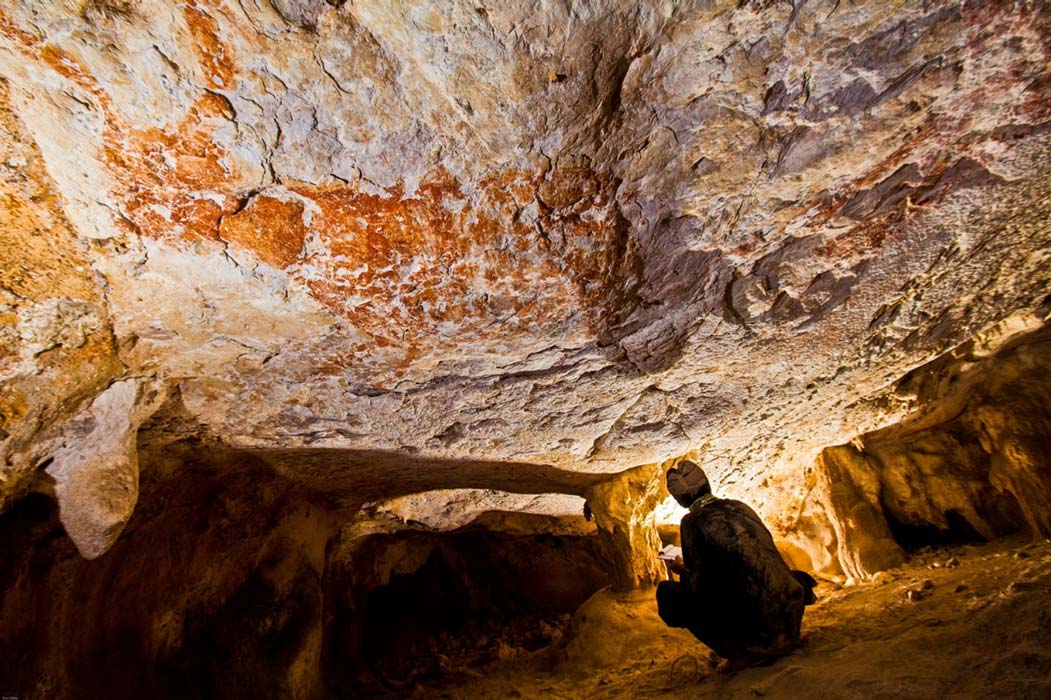Figurative Art Discovered Deep in Indonesian Cave is the Oldest in the World
Cave paintings offer an invaluable insight into the lives and minds of early humans. Experts, working in Borneo, Indonesia have made a potentially historic discovery in a remote karst cave system. They believe that they have identified, possibly the earliest example of figurative art. This discovery could revolutionize our understanding of the prehistory of Indonesia and the wider Pacific. It could also help us to understand the development of our ancestors.
Cave art in Borneo
A team of archaeologists from Griffith University in Queensland, Australia, led by Maxime Aubert, were investigating art in caves in East Kalimantan in Borneo. The caves had been identified as a site of early human activity by a French team in the 1990s. They were the first to have studied the images, but the paintings were not fully investigated because they are located in ‘series of difficult-to-access caves on the island’ reports NBC News. Now the team has produced a report, published in Nature magazine, and has identified some of the oldest examples of figurative artwork in the world.

The world’s oldest figurative artwork from Borneo, depicting cattle-like creatures and dated to a minimum of 40,000 years. Image: Luc-Henri Fage
The discovery of the images
This part of Borneo has thousands of images of prehistoric cave-art, which have been grouped by experts into three different styles. In the caves, the Australians identified ancient handprints, some human figures, and in the Lubang Jeriji Saléh cave three images of cattle-like images. The experts immediately knew the pictures of the animals were very important. According to the Guardian one of the depictions is ‘faded and fractured, the reddish-orange image depicts a plump but slender-legged animal’. In at least one of the images, there seems to be a representation of a hunter’s spear sticking out of the back of the animal. The figure is very like that of wild cattle that still roam the island of Borneo.
Hands of time
Around the three bovine figures are a series of human hands prints. The Guardian reports that “these ghostly markings, which appear singularly or in groups, are made by spraying ochre paint from the mouth over a hand pressed on to the rock.” They are typical of early human art and similar patterns have been discovered in caves around the world. The meaning of the art is difficult to establish, they could have been religious symbols, records of successful hunts or they were possibly believed to provide mystical help to hunters when pursuing these animals.

Different colored hand stencils are separated in time by at least 20,000 years. (Image: Kinez Riza)
What is distinctive about this art is that there are two sets of hand stencils over-laid on each other. Tests on the oldest handprints indicate that they date as far back as 37,000 years ago. The top layers of stencils were around 20-25,000 years younger than this, suggesting that the remote caves were important in local culture for millennia.
- New Research May Establish Australian Rock Art as the Oldest in the World
- Did Humans Speak Through Cave Art? Ancient Drawings and Language's Origins
- Life Before the Clovis: Portable Rock Art as Evidence of Pre Ice Age Humans in North America
Finding the oldest figurative images
Researchers had found that establishing ‘the exact dates’ for the images had proven difficult reports the Independent. However, the Australian experts provided the date of the images by testing deposits of limestone that formed in the caves’ dues to rainwater. They tested some deposits that were underneath the bovine images. This was to determine when the ochre- pigment was applied to the wall during the process of painting the images. The researchers were excited by what they discovered - the images of the bovine figures were at least 40,000 years old!
This means that the cow-like images are the oldest yet found in Indonesia. Their report in the scientific journal Nature also claims that they are the oldest ‘ figurative artwork from anywhere in the world.’ They are considerably older than those found in the neighboring island of Sulawesi. Moreover, it also means that the oldest rock art is no longer to be found in France or Spain. The Guardian reports that Aubert, the team-leader, claimed that the images are ‘an intimate window into the past.”
What do the images tell us?
The dating of the images has now allowed researchers to establish the development of cave-art in South East Asia. It seems to have begun over 50,000 years ago and continued until 5000 years ago. Whether the different styles ‘was part of the natural evolution of art or came with the arrival of another wave of humans, no-one knows’ reports the Independent. While the images of the cattle may be the oldest known figurative art they are not the oldest artistic representation. In Kimberly, Australia there are Aboriginal paintings believed to be 55,000 years old and what is believed to be a rudimentary image, dated to over 70,000 years ago has been uncovered recently in East Africa.
The dating of the image is very significant because it has been theorized that these paintings played a pivotal role in human cognitive development and even language. Moreover, the cave art in Borneo appeared at roughly the same time as in Europe. The images in the remote caves will allow us to understand the evolution of our early ancestors.
Top image: Figurative art depicting wild cattle, dated at about 40,000 years old, in a cave in East Kalimantan, Borneo. Source: Pindi Setiawan/Griffith University
By Ed Whelan

















